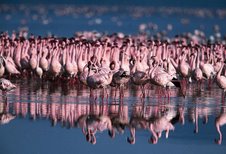Bird migration is one of the great mysteries of nature. The earliest recorded observations of bird migration were 3000 years ago, as noted by Hesiod, Homer, Herodotus, Aristotle and others. The Bible also notes migrations, as in the Book of Job (39:26), where the inquiry is made: "Doth the hawk fly by Thy wisdom and stretch her wings toward the south?" The author of Jeremiah (8:7) wrote: "The stork in the heavens knoweth her appointed time; and the turtledove, and the crane, and the swallow, observe the time of their coming."
Each year, millions of birds leave the comfort of Africa and fly across deserts, mountains and oceans. They fly north to Europe and Asia, where they build their nests and raise their young. A few months later they undertake another great journal to return to Africa.
They fly north when it is spring and summer. There at that time, the sun is over northern hemisphere. Spring and summer days in northern countries are much longer than the nights. The sun may rise at 4am and set at 9pm north of the Arctic Circle. The sun does not set at all in mid June. This gives the birds plenty of time to look for insects to feed their young.
Sometimes circumstances such as a good breeding season followed by a food source failure the following year lead to interruptions in which large numbers of a species move far beyond the normal range.
The primary advantage of migration is conservation of energy. The longer days of the northern summer provide greater opportunities for breeding birds to feed their young. The extended daylight hours allow diurnal birds to produce larger clutches than those of related non-migratory species that remain in the tropics year round. As the days shorten in autumn, the birds return to warmer regions where the available food supply varies little with the season.
During the cold, dark months of the northern winter, few insects survive. With the coming of warm, sunny days, insects hatch in large numbers. The resident birds cannot manage to eat them all. This leaves plenty of insects for food for migratory birds to eat and feed their young.
In fresh water wetlands and seashores, tiny crustaceans also multiply in the summer, and eventually there is abundant food for wetland birds.
Some large birds such as White Stocks may follow landmarks along their route while some small birds such as Nightingales migrate at night and may be guided by the stars. Scientists continue to study migrating birds hoping to understand how they make that amazing journey.
Migrating does not only happen to Africa. Birds also migrate from southern Asia and Australia to northern Asia; and from South and Central America for instance; The Arctic Tern, a beautiful silvery seabird migrates from Arctic Circle in the north all the way to the Antarctic in the south. A few birds migrate in other directions: from the tropics to lands far in the south and back again.
In Kenya, more than 100 species of birds migrate to Kenya from other continents. Some of these stay in Kenya until they fly north again. Others continue their migration to southern Africa while a few migrate to Kenya from Madagascar and southern Africa.
Migratory birds in Kenya safari include White Stocks, Plovers and Sandpipers, Barn Swallows and Nightingales among many others. Usually Migrating birds follow directions called flyways. In Kenya, flyways pass through the coastal and eastern lowlands, the central highlands, the rift valley and Lake Victoria.
You don’t need to be a birder to enjoy seeing migrating flocks. All you need is a spirit of adventure, and enjoy being outdoors.
PKP-Kenya safari desk
Natural Track Safaris








